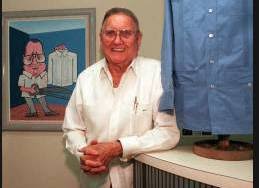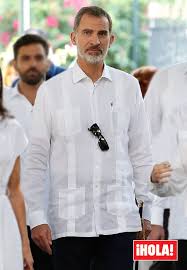CIERRA EN EEUU POR LA PANDEMIA “LA CASA DE LA GUAYABERA”. HISTORIA DE RAMÓN PUIG “EL REY DE LA GUAYABERA”
Con un breve mensaje en su página del Internet en Agosto del 2020 la famosa mundialmente “Casa de La Guayabera” de Ramon Puig en la Calle Ocho de Miami, Florida, cerró sus puertas para siempre, despues de 77 años sirviendo a una clientela internacional.
Fué Ramón Puig llamado el ‘Rey de las Guayaberas’ en Cuba y de hecho el fabricante conocido más importante. Puig, natural de Zaza del Medio en Sancti Spíritus y que emigró a Estados Unidos después de la Revolución y montó en la Calle 8 de Miami su famosa ‘Casa de las Guayaberas’ donde siguió cortando hasta su muerte a los 90 años de edad.
Abrió su primera tienda de venta de guayaberas en 1943 y desde hace 40 años radicaba en Miami. Por más de 70 años “el rey de la guayabera” diseño y confeccionó esta auténtica joya tropical cubana para Ernest Hemingway, Robert De Niro, Robert Duvall, Andy Garcia ,Alonzo Mourning, Sylvester Stallone y muchos líderes mundiales incluyendo a los presidentes de Estados Unidos Carter, Reagan, Clinton y Bush.
Ramon Puig fue proclamado como “el maestro de la guayabera” y el más grande fabricante de guayaberas de todos los tiempos. Muchos han tratado de copiar esta prenda clásica cubana con imitaciones producidas masivamente, pero los conocedores no han podido ser engañados, e insisten en la autentica guayabera Ramón Puig. Sabiamente decia Ramón, “usted no fumaría falsos habanos, por lo tanto, no usaría una guayabera que no sea genuina.
ORIGEN DE LA GUAYABERA
La historia enseña las guayaberas se originaron en Sancti Spiritus, Cuba. En 1709 llegaron a dicha ciudad, procedentes de Granada, don José Pérez Rodríguez y su esposa Encarnación Núñez García. José era alfarero y le llamaban “Joselillo”. Después de estar trabajando un corto tiempo en su alfarería, o tejar como también comúnmente se le llama, los cuales abundan en la zona y tienen fama por su calidad, recibieron varias piezas de tejidos que sus familiares les enviaron desde España.
Fue inmensa la alegría que ambos experimentaron cuando les fue entregado el paquete de tela, porque Encarnación, como la mayoría de las mujeres en esos tiempos, era costurera. Tiempo más tarde Josélillo le pide a Encarnación, que le hicieras camisas largas con bolsillos grandes a los lados, “para poder llevar la fuma y otras cosillas al talle”. Después de varias pruebas Encarnación pudo coser una prenda de vestir que fue del agrado de su esposo. Josélillo, el cual la comenzó a usar con mucho orgullo. Los guajiros, como llaman en Cuba a los campesinos, viendo la comodidad y la economía que resultaba de esta prenda de vestir, también comenzaron a usarla.
La primera denominación fue “yayabera”, por usarse en la zona del río Yayabo, en Sancti Spiritus. Pero se dice que los labriegos acostumbraban a acopiar guayabas y a guardarlas en sus grandes bolsillos. De ahí que cambiara pronto el nombre por el de guayabera.
Prácticamente todas las versiones coinciden en que el origen de la prenda es de la Cuba española.
LA GUAYABERA DE NACIONAL A INTERNACIONALMENTE CONOCIDA
La guayabera, una camisa de mangas cortas o largas, cuatro bolsillos e hileras de alforzas al frente y en la espalda, es la prenda nacional de Cuba, muy difundida y usada en América Latina, sobre todo de color blanco y tejidos frescos, que la hace apropiada para el clima tropical.
En 1967, el cubano George Feldenkreis y su hermano Isaac, fundaron ‘Supreme International’. Comenzaron importando uniformes escolares de niños de Japón a Puerto Rico, y luego se centraron en las guayaberas, las camisas tropicales bordadas de cuatro bolsillos, uno de los símbolos más auténticos de la cultura latina. La empresa cambió su nombre de ‘Supreme International’ a ‘Perry Ellis International’ para reflejar mejor el reconocimiento del nombre que brinda esa marca. Perry Ellis International es una de las empresas de indumentaria deportiva para hombres más grande del mundo.
A partir del éxito de Perry Ellis International, George y Oscar Feldenkreis decidieron capitalizar el crecimiento, el potencial y el atractivo de la cultura latina llevándolo a una marca de estilo de vida. Y así fue como fundaron Cubavera en 2000.
En su visita de tres días a Cuba, el ex presidente estadounidense Jimmy Carter, vistió todo el tiempo guayaberas blancas de mangas largas. Cuba, donde usar cuello y corbata es una verdadera tortura térmica, acaba de establecer la guayabera, masculina o femenina, como prenda oficial para ceremonias diplomáticas o de Estado, en una resolución publicada.
La verdad es que el uso de la guayabera por parte de los funcionarios públicos no es nuevo, porque ya en 1973, el coronel Molina, en su calidad de Presidente de El Salvador, oficializó esa vestimenta que fue aceptada por cómoda, fresca y porque ayudaba a contrarrestar lo caluroso del clima.
Por la misma época algo parecido sucedió en México, con el presidente Echeverría e incluso con esa prenda recibía a visitantes extranjeros, sobre todo cuando las reuniones eran en la costa o en zonas de altas temperaturas. La Cumbre de las Américas, celebrada en Cartagena en 2012 vistió con Guayaberas a los mandatarios participantes.
En Abril de 2014 se realizó la VI Cumbre de la Asociación de Estados del Caribe, en Mérida, Yucatan y todos vistieron de Guayabera. La moda, e incluso el protocolo, llevan a políticos de todas las gamas ideológicas a optar por la frescura y elegancia de la guayabera para ciertas actividades de sus cargos. Las han usado siendo Presidentes de México Luis Echeverría Álvarez, José López Portillo, Miguel de la Madrid, Felipe Calderón y Enrique Peña Nieto
Convertida en prenda cómoda, elegante y sencilla, los cantantes más afamados de Cuba, como el gran Benny Moré, empezaron a usarla en sus recorridos por América. Famosos del medio artístico como Ricky Martin ha llegado a usarlas en sus conciertos. Actores norteamericanos como Robert Duval, Robert de Niro o Sylvester Stallone aparecieron en algunas de sus películas con guayaberas.
Sin duda habrá a quien no le guste, habrá quien las considere antiguas u obsoletas, pero su elegancia, comodidad y frescura la hacen una prenda inimitable.
“LA CASA DE LA GUAYABERA” CLOSES IN THE US DUE TO THE PANDEMIC. THE RAMÓN PUIG “THE KING OF GUAYABERA” STORY
With a brief message on his website in August 2020 the world-famous “Casa de La Guayabera” by Ramon Puig on Calle Ocho in Miami, Florida, closed its doors forever, after 77 years serving an international clientele.
Ramón Puig was called the ‘King of the Guayaberas’ in Cuba and in fact the most important known manufacturer. Puig, a native of Zaza del Medio in Sancti Spíritus and who emigrated to the United States after the Revolution and set up his famous ‘Casa de las Guayaberas’ on Calle 8 in Miami where he continued cutting until his death at 93 years of age. age.
He opened his first guayabera store in 1943 and has been in Miami for 40 years. For more than 70 years “the king of the guayabera” designed and made this authentic Cuban tropical jewel for Ernest Hemingway, Robert De Niro, Robert Duvall, Andy Garcia, Alonzo Mourning, Sylvester Stallone, and many world leaders including Presidents Reagan, Clinton, Obama, and Bush.
Ramon Puig was proclaimed as “the master of the guayabera” and the greatest manufacturer of guayaberas of all time. Many have tried to copy this classic Cuban garment with mass-produced imitations, but connoisseurs have not been fooled, and insist on the authentic Ramón Puig guayabera. Ramón wisely said, “you would not smoke fake cigars, therefore, you would not use a guayabera that is not genuine.
ORIGIN OF LA GUAYABERA
History teaches the guayaberas originated in Sancti Spiritus, Cuba. In 1709, Don José Pérez Rodríguez and his wife Encarnación Núñez García arrived in that city from Granada. José was a potter and they called him “Joselillo”. After working for a short time in their pottery, or weaving as it is also commonly called, which are abundant in the area and are famous for their quality, they received several pieces of fabrics that their relatives sent them from Spain.
The joy they both experienced when the cloth package was delivered to them was immense, because Encarnación, like most women at that time, was a seamstress. Sometime later, Josélillo asked Encarnación to make him long shirts with large pockets on the sides, “to be able to wear the smoke and other things to the waist.” After several tests, Encarnación was able to sew a garment that her husband liked. Josélillo, who began to use it with great pride. The guajiro, as they call the peasants in Cuba, seeing the comfort and economy that resulted from this garment, also began to use it.
The first denomination was “yayabera”, to be used in the Yayabo river area, in Sancti Spiritus. But it is said that peasants used to collect guavas and store them in their large pockets. Hence, the name was soon changed to guayabera.
Virtually all versions agree that the origin of the garment is from Spanish Cuba.
LA GUAYABERA FROM NATIONAL TO INTERNATIONAL KNOWN
The guayabera, a shirt with short or long sleeves, four pockets, and rows of tucks on the front and back, is the national garment of Cuba, widely spread and used in Latin America, especially white in color and fresh fabrics, which makes it appropriate for the tropical climate.
In 1967, Cuban George Feldenkreis and his brother Isaac founded ‘Supreme International’. They began by importing children’s school uniforms from Japan to Puerto Rico and then focused on guayaberas, the four-pocket embroidered tropical shirts, one of the most authentic symbols of Latino culture. The company changed its name from ‘Supreme International’ to ‘Perry Ellis International’ to better reflect the name recognition provided by that brand. Perry Ellis International is one of the largest men’s sportswear companies in the world.
Building on the success of Perry Ellis International, George, and Oscar Feldenkreis decided to capitalize on the growth, potential, and appeal of Latino culture by bringing it to a lifestyle brand. And that’s how they founded Cubavera in 2000.
During his three-day visit to Cuba, former US President Jimmy Carter always wore long-sleeved white guayaberas. Cuba, where wearing a collar and tie is true thermal torture, has just established the guayabera, male or female, as an official garment for diplomatic or state ceremonies, in a published resolution.
The truth is that the use of the guayabera by public officials is not new, because already in 1973, Colonel Molina, in his capacity as President of El Salvador, made official this clothing that was accepted as comfortable, fresh, and because it helped to counteract the hot weather.
Around the same time, something similar happened in Mexico, with President Echeverría and even with that garment, he received foreign visitors, especially when the meetings were on the coast or in areas of high temperatures. The Summit of the Americas, held in Cartagena in 2012, dressed the participating leaders in Guayaberas.
In April 2014, the VI Summit of the Association of Caribbean States was held in Mérida, Yucatan and everyone wore Guayabera. Fashion, and even protocol, lead politicians of all ideological ranges to opt for the freshness and elegance of the guayabera for certain activities of their positions. They have been used as Presidents of Mexico Luis Echeverría Álvarez, José López Portillo, Miguel de la Madrid, Felipe Calderón, and Enrique Peña Nieto
Converted into a comfortable, elegant, and simple garment, the most famous singers of Cuba, such as the great Benny Moré, began to use it on their tours of America. Famous for artistic means like Ricky Martin has gotten to use them in the concerts him. American actors such as Robert Duval, Robert de Niro, or Sylvester Stallone appeared in some of his films with guayaberas.
Without a doubt there will be those who do not like it, there will be those who consider them old or obsolete, but their elegance, comfort, and freshness make them an inimitable garment.
Agencies/ Wiki/ Memorias Cubanas/ Carlos RodriguezB./ Internet Photos/ Extractos/ Excerpts/ Arnoldo Varona/ www.TheCubanHistory.com
THE CUBAN HISTORY, HOLLYWOOD.














